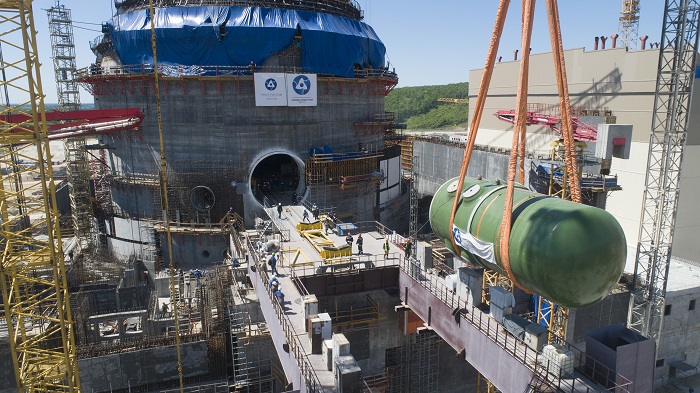The VVER-TOI reactor pressure vessel (RPV) has been installed at unit 1 of the Kursk-II NPP under construction in Russia, three weeks ahead of schedule, said Andrey Osharin, First Deputy Director for the Construction of New Units at Kursk NPP. The RPV was delivered to the site in September 2021.
“Since that time, a lot of work has been done to prepare a transport and technological scheme for the installation. The installation of the hull in its regular place marks the active phase of the installation of the equipment of the reactor plant. This event paves the way for the start of commissioning,” said Osharin, emphasising the significance of the event.
The operation was carried out in several stages. First, a Liebherr crawler crane brought the RPV to the transport portal of the power unit and loaded it onto a special transport trolley. Then the equipment was moved to the central hall of the reactor compartment and, using a polar crane, was installed on a support ring in the reactor shaft. The maximum allowable deviation during installation was one tenth of a millimetre – the thickness of a razor blade.
“The VVER-TOI reactor vessel has its own characteristics. It differs from the VVER-1200 project not only with a more symmetrical arrangement of nozzles, but also in the smaller number of welds – four instead of six as there are no welded joints in the core area,” said Alexei Volnov, Chief Engineer of Kursk NPP. “This provides an improvement in performance, given that radiation exposure adversely affects the structure of a weld. This modernisation will make it possible, after 60 years of operation, to extend the service life of the hull twice more, each time by 20 years.”
Oleg Shperle, Vice President and Director of the Kursk NPP construction project, said that, having realised the key task of 2022, “we will not stop and will continue preparations for welding the main circulation pipelines, the installation of which will begin in the near future”.
The VVER-TOI RPV weighs 340 tons and is 12 metres long. “It is made of nickel-free steel, which does not change its properties under the influence of radiation and at high temperatures. The product is able to withstand a pressure of 250 atmospheres, which is 1.4 times higher than the previous RPV. The equipment was manufactured at the Atommash plant in Volgodonsk.
Currently, equipment is also being tested at the pumping station for feeding the storage reservoir for Kursk-II. Two of the four pumping units have already been tested and are ready for operation. The station is located on the banks of the Seim River. Pumps are located in the underground part of the station, and electric motors are installed in the above-ground part of the building. This arrangement of pumps is a distinctive feature of the Kursk-II project,” explained Osharin.

The pumping station includes four powerful electric pumping units – one for each power unit (based on a four-unit NPP). Each pump is capable of pumping up to 12,600 cubic metres of water per hour. “The operation of the station will not affect the ecosystem of the river, since water will be pumped only during the flood period. In addition, the station is equipped with special devices that prevent fish from entering the water intake,” explained Chief Engineer Volnov.
The task of the make-up pumping station is to supply water to storage reservoir designed to replenish the loss of water used in the cooling tower to cool the steam from the turbine. In addition, water from the reservoir is also the source for obtaining chemically desalted water, which is used in the primary circuit of the reactor compartment and which is the main coolant of the NPP.
Kursk-II is a replacement station for the current Kursk nuclear plant. Commissioning of the first two units with the new design VVER-TOI reactors will be synchronised with the decommissioning of the RBMK reactors at Kursk 1&2 of the operating plant. Kursk 1 of the existing plant was permanently closed down in December 2021.
Leave a Reply